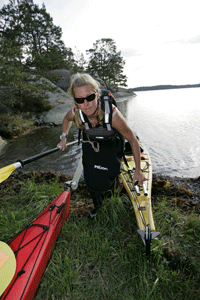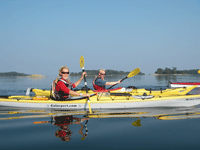- Details
- Written by: David
Kayaking in Sweden
Careering sideways over the mulchy track, my mountain bike landed on top of me. It happened in slow motion, I could see people were scrambling to reach me through the screen of tree-trunks. After a time delay of what felt like several seconds, the adrenaline kicked in. I got up, laughed, and dusted myself off. Not even a graze to show for it, but I would have a purplish-black plum of a bruise.
We were on a tour of Stockholm, and our group skidded and pumped the pedals of our bikes in the National Park that is in the space between the city and the airport. In the background, like a stage backdrop, appeared the city, with Gothic townhouses, warehouses and municipal buildings on the outskirts of town.
A city built on 14 islands on Sweden’s eastern coast, Stockholm is where Lake Mälaren meets the Baltic Sea, and you can kayak between the different districts.
Stockholm is the westernmost part of an archipelago of more than 20,000 islands, and many Swedes have weekend or holiday homes out on the islands, which are predominantly covered with pine, oak and silver birch trees. Inhabiting the archipelago are deer that swim between the islands, rare sea eagles, silver tern, cormorants and eider ducks. Lumbering around the woods are massive moose and in the water are grey seals measuring up to 2m long plus plenty of pike, perch and herring.
Barely a three-hour flight from the UK and a short ferry-ride away, you can soon be enjoying your new green surroundings, going for a refreshing dip in the water (it’s called Baltic for a reason), and pitching your tent. The air smells fantastic – crushed mushrooms, warm earth and pine trees. It has a cleansing effect on me, and I take in a few deep lungfuls, making me feel instantly relaxed.
On the island of Finhamn, there is a hostel with cosy bunkrooms and communal showers – catch an early shower if you want it to be a hot one. Also belonging to the hostel, there is a restaurant in an old converted boat-house, and a campsite. Although there is right of public access on the archipelago, most of the larger inhabited islands will have a campsite with basic amenities such as compost toilets and a campfire set-up. for you to use. The campsite on Finhamn also has an old-fashioned water pump. Charming if you’re fetching water in daylight hours, but not so charming in the bleary light of dawn – particularly when juggling water bottle, toothbrush and toothpaste and the pump handle.
The site itself overlooks a small bay and is surrounded by forest. There is a perfect stargazing rock to sit on and ruminate while watching the shooting stars and satellites. It is extremely satisfying to eat pickled herrings, laax (salmon with crème fraiche and herbs), potato salad and tomato salad while lazing around the campfire. This is more than the simple life – this is the good life.
Locally-sourced and plentiful food makes a happy camper. It’s pretty essential to have a decent meal in your belly when you are sea kayaking in the archipelago. You’ll need all your energy to work your paddles through the water.
Navigation is a difficult task out among the many islands and rocky outcrops. Our guide Anne-Sofia was demonstrating how we should punch our paddles through the water rather than drag the blades. Anne-Sofia told me: ‘Imagine it is your ex-boyfriend!’ After that, I was sprinting so fast that my partner in the double sea-kayak, Bob, had to ask me to slow down. Soon we were steaming along at a decent rate, and the rhythm of the paddling took on a more meditative quality.
Next day, next island. Grinda was just as gorgeous as Finhamn, and was only one and a half hours to the southwest by ferry. The campsite on Grinda was very spacious and located near the water. Walking around the coastline at sunset was dreamlike, with enormous red and white toadstools by the edge of the path and wild rose bushes growing up among the trees. It was a fairytale, and I was half expecting elves to jump out from behind the pine trunks.
That night, there was a traditional crayfish party. The aim of the crayfish party is to get rapidly and outrageously drunk on schnapps (think grappa not Archers), eat as many crayfish as is humanly possible and belt out drinking songs. As far as traditions go, it’s not a bad one – until the 60 per cent proof hits you over the head with a sledgehammer the next morning.
Continued...
 Sore head in tow, we left Grinda for the island of Üto, which is larger and more populated than Finhamn or Grinda. Üto used to have several coalmines, but is now a stylish holiday island, with many visiting yachts. The harbour was a forest of masts. There was a hotel, cycle rental shop (a corner of the harbour shop) and even a nightclub. There are several campsites on Üto, so take your pick depending on whether you’d like to witness the sunrise, thereby choosing the site on the eastern shore, or whether you want to be within stumbling distance of Üto Värdhaus, a smart restaurant, inn and club.
Sore head in tow, we left Grinda for the island of Üto, which is larger and more populated than Finhamn or Grinda. Üto used to have several coalmines, but is now a stylish holiday island, with many visiting yachts. The harbour was a forest of masts. There was a hotel, cycle rental shop (a corner of the harbour shop) and even a nightclub. There are several campsites on Üto, so take your pick depending on whether you’d like to witness the sunrise, thereby choosing the site on the eastern shore, or whether you want to be within stumbling distance of Üto Värdhaus, a smart restaurant, inn and club.
While simple things like buying a beer or a simple meal may be a little more expensive in Sweden than we’re used to in Britain, a holiday island-hopping couldn’t be easier or cheaper. A Båtluffarkortet (island-hopping pass) is available from the Stockholm ferry terminus, and costs £22 for unlimited access over 5 days, or you can put fares on an electronic card, saving 25 per cent of the full price of a crossing. Timetables are available at each port and in local tourist offices. And if you’re camping, Sweden suddenly becomes supremely affordable. For a small fee of about £5 per tent you can pitch up and rest your head. And on lots of the islands you can rent a bike or kayak at reasonable rates.
Whether you are on Üto, Finnhamn or Grinda, one thing is for certain, you are sure to be beguiled by the charm, natural beauty and healthy pleasures that the islands have on offer. Arm yourself with a torch to find your way back to your pitch, long sleeves to guard against mozzies and ticks, and a camera so that you can capture that moment should you come face to face with a two-metre tall moose.
Getting there
SAS (www.scandinavian.net ) flights from London to Stockholm. For a transfer to Stockholm, Arlanda Express (www.arlandaexpress.com) trains take you from the airport to Stockholm in 20 mins.
Ferries are run by Waxholmsbolagel, you can see the rates and timetables on www.waxholmsbolaget.se
Accommodation
For more info on campsites:
Grinda:
Tel: +46 (0)8 542 490 72
www.grinda.nu (for the hotel: Grinda Wärdshus www.grindawardshus.se
Tel: +46 (0)8 542 494 91)
Utö:
Tel: +46 (0)8 501 574 50
www.utoturistbyra.se (for the hotel: Utö Värdshus www.utovardshus.se
Tel: +46 (0)8 504 203 00)
Finnhamn:
Tel: +46 (0)8 542462 12
www.finnhamn.nu
Activities
Sea-kayaking with Kajak & Uteliv www.kajak-uteliv.com
Guided cycle tours of Stockholm with Event Seven www.eventseven.com
More info
For more info on travel in Sweden see
www.visitsweden.com
Images: Marco Felgenhauer




